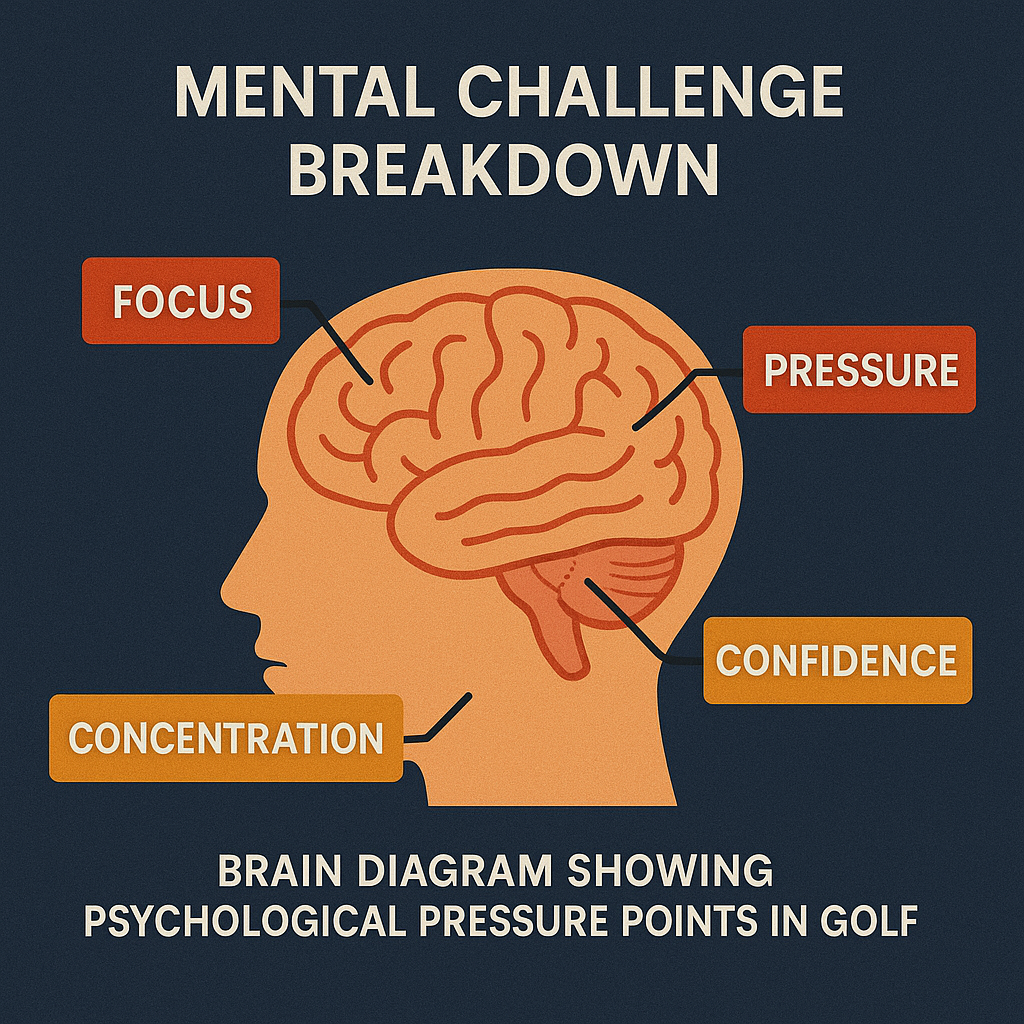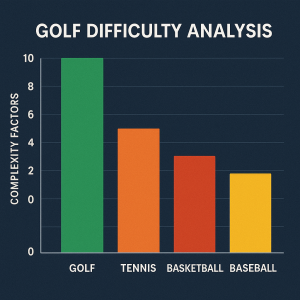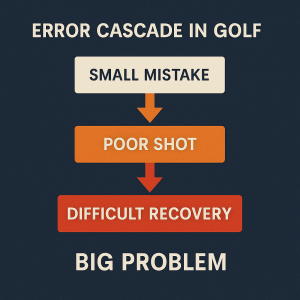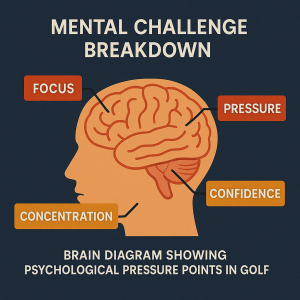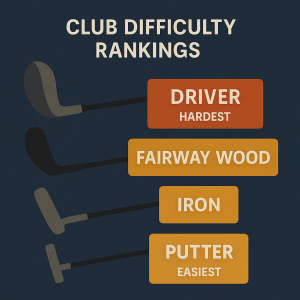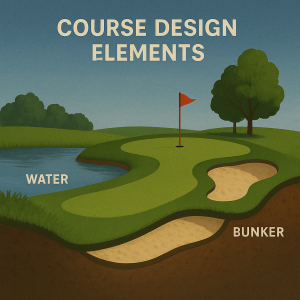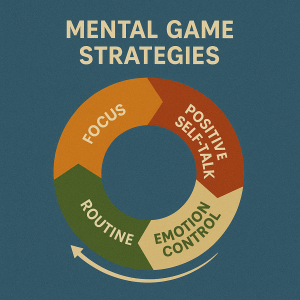Why Is Golf So Hard? The Real Reasons Golf Is Difficult (And How to Make It Easier)
Last Updated: July 2025
"This is impossible!"
You've just spent four hours chasing a little white ball around 18 holes, and you're questioning every life decision that led you to this moment.
Your driver betrayed you, your putter has commitment issues, and you're starting to think golf was invented by someone who genuinely disliked humanity.
If you've ever wondered why golf feels impossibly difficult while other sports seem more forgiving, you're asking the right question.
After analyzing the mechanics, psychology, and physics of golf for over two decades, I can tell you that golf's difficulty isn't just in your head—it's built into the very fabric of the game.
The truth is: Golf combines more complex variables than virtually any other sport, demands millimeter precision, and punishes mistakes more severely than almost any other activity.
But understanding WHY golf is hard is the first step to making it easier.
In this deep dive, you'll discover:
- The scientific reasons golf is uniquely difficult
- Why your brain works against you on the golf course
- How golf's scoring system amplifies frustration
- The equipment factors that make consistency nearly impossible
- Proven strategies to make golf feel easier and more enjoyable
- Mental frameworks that transform your relationship with the game
Let's explore why golf has humbled everyone from weekend warriors to world-class athletes—and how you can finally start winning the battle.
The Scientific Truth: Golf Is Objectively Difficult
The Precision Problem
Golf demands unprecedented accuracy:
- Target tolerance: A golf hole is 4.25 inches wide—imagine trying to roll a basketball into a soup can from 20 feet away
- Swing precision: A 1-degree difference in clubface angle equals 20+ yards offline
- Distance control: Must hit targets within 5-10 yard windows consistently
- Timing window: Impact occurs in 1/2000th of a second
According to biomechanics research from leading sports science institutions, golf requires more precise motor control than brain surgery.
The margin for error in a golf swing is smaller than most industrial manufacturing processes.
The Static Ball Paradox
Why hitting a stationary ball is harder:
- No momentum assistance: Unlike tennis or baseball, you create all the energy
- Perfect timing required: You must generate speed and accuracy simultaneously
- No reaction time: You have too much time to think and overthink
- Pressure amplification: Every swing feels like a test of your ability
Comparison to other sports:
- Baseball: Ball coming at you forces reactive timing
- Tennis: Natural rhythm from ball exchange
- Basketball: Muscle memory from repetitive motion
- Golf: Cold start every single shot
The Compound Error Effect
Single mistakes create multiple problems:
- Miss fairway → Difficult lie → Poor approach → Missed green → Difficult chip → Three-putt
- One bad swing can cost 2-3 strokes
- Recovery shots often require perfect execution
- No "reset" button like other sports
Error multiplication factors:
- Course design amplifies mistakes (hazards, rough, slopes)
- Equipment magnifies swing flaws (driver vs. wedge forgiveness)
- Mental pressure compounds (thinking about previous mistakes)
- Scoring system punishes (every stroke counts equally)
The Mental Game: Your Brain Is Not Your Friend
Why Golf Breaks Your Mind
Golf violates how your brain wants to work:
1. Too Much Thinking Time
- 4+ hours of play with only 4 minutes of actual swinging
- Excessive time to analyze, worry, and overthink
- No flow state like other continuous sports
- Mental fatigue from constant decision-making
2. Perfectionist's Nightmare
- Every shot matters equally in scoring
- Impossible to achieve true "perfection"
- Success measured against an ideal (par) rather than opponents
- Previous holes affect confidence for remaining holes
3. Delayed Feedback Loop
- Results don't always match effort or technique
- Good swings can yield bad results (and vice versa)
- Weather, lies, and luck affect outcomes
- Improvement isn't always linear or obvious
The Confidence Paradox
Golf requires confidence but destroys it systematically:
- Need confidence to make aggressive, committed swings
- Course punishes confidence with hazards and difficult shots
- Bad shots linger in memory longer than good ones
- Comparison culture makes everyone feel inadequate
The vicious cycle: Bad shot → Loss of confidence → Tentative swing → Worse shot → Greater loss of confidence
Why Your Brain Struggles With Golf
- Evolution Problem: Humans evolved for survival, not precision
- Pressure Response: Fight-or-flight doesn't help with finesse
- Analysis Paralysis: Too much time to think between shots
- Perfectionism: Brain seeks patterns that don't exist in golf
- Social Pressure: Playing with others amplifies stress
The Equipment Challenge
Why Golf Clubs Work Against You
Golf equipment is inherently inconsistent:
14 Different Tools for One Job
- Each club behaves completely differently
- Must master 14 separate swing techniques
- No other sport requires this much equipment variation
- Constant club selection decisions add complexity
Technology Promises vs. Reality
- Modern clubs are more forgiving but expectations rise
- Distance increases create new problems (longer courses, more hazards)
- Choice paralysis from too many options
- Equipment becomes a crutch instead of a tool
Club difficulty ranking (hardest to easiest):
- Driver: Longest, least lofted, most unforgiving
- Long irons (3-4): Low loft, small sweet spot
- Fairway woods: Length vs. precision balance
- Mid irons (5-7): Moderate difficulty, versatile
- Short irons (8-9): Higher loft, more forgiving
- Wedges: Shortest, most loft, easier contact
- Putter: Slowest swing, most practice
The Lie Variable
Every shot is different:
- Ball above/below feet
- Uphill/downhill lies
- Rough, sand, hardpan
- Wind conditions
- Pin positions
No practice replicates course conditions:
- Range: Perfect lies, no pressure, same target
- Course: Variable lies, pressure, different targets every shot
- Practice doesn't transfer to performance
Course Design: Built to Frustrate
How Golf Courses Amplify Difficulty
Strategic Punishment Systems:
Risk-Reward Dilemmas
- Forced to choose between safe and aggressive
- Conservative play often doesn't lead to good scores
- Aggressive play punished severely
- No "right" answer on many shots
Hazard Placement Psychology
- Water hazards placed where natural misses occur
- Bunkers positioned in landing areas
- Trees guard recovery routes
- Rough thickness varies unpredictably
Visual Intimidation
- Hazards appear larger from tee
- False fronts on greens
- Forced carries over trouble
- Optical illusions on slopes
The Distance Deception
Modern golf courses are too long for average players:
- Average golfer drives: 220 yards
- Average course length: 6,500+ yards
- Professional course setup: Designed for 300+ yard drives
- Result: Average players always playing longer clubs into greens
Length compounds every other difficulty:
- Longer shots = less accuracy
- More club = less forgiveness
- Greater distance = larger misses
- Fatigue from longer walks between shots
The Scoring System That Punishes
Why Golf's Scoring Makes Everything Harder
Golf scoring is uniquely unforgiving:
Every Shot Counts Equally
- First tee shot = Final putt in terms of score
- No time outs, substitutions, or do-overs
- Bad holes can't be "forgotten" statistically
- Momentum doesn't exist in golf scoring
Comparison to "Perfect" Standard
- Par represents ideal play, not average
- Always measuring against perfection
- Other sports measure against opponents
- Creates unrealistic expectations
The Disaster Multiplication Effect
- One bad hole can ruin an entire round
- Double bogey feels exponentially worse than bogey
- Scoring system amplifies mental pressure
- Recovery from bad holes requires perfect play
Golf Scoring vs. Other Sports
- Basketball: Miss 10 shots, make 5 → Still contributing
- Baseball: 7 out of 10 failures = Hall of Fame career
- Tennis: Win more points than opponent = Victory
- Golf: Every mistake permanently recorded and counted
Making Golf Easier: Practical Solutions
Course Management Strategies
Play Golf Backwards:
- Start with where you want your ball to end up
- Work backwards to determine best approach
- Choose clubs based on miss patterns, not perfect shots
- Accept bogey as a good score on difficult holes
The 80/20 Strategy:
- Play 80% conservative, 20% aggressive
- Take risks only when the reward significantly outweighs penalty
- Lay up more often than you think you should
- Target middle of greens, not pins
Distance Control Over Direction:
- Focus on solid contact over perfect direction
- Leave yourself full swing distances when possible
- Favor shorter clubs over longer ones
- Practice lag putting more than short putts
Mental Game Improvements
Expectation Management:
- Realistic goals: Par is for professionals
- Process focus: Judge swings, not results
- Selective memory: Remember good shots longer
- Comparative perspective: Measure against your own improvement
Pre-Shot Routines:
- Limit decision time to reduce overthinking
- Same routine for every shot type
- Focus on target, not hazards
- Positive visualization only
Post-Shot Recovery:
- 10-second rule: Get over bad shots quickly
- Focus on next shot, not previous mistake
- Physical reset routine (deep breath, shoulder roll)
- Learn from mistakes but don't dwell
Equipment Solutions
Beginner-Friendly Equipment Choices:
Clubs That Make Golf Easier:
- Higher lofted driver (10.5-12 degrees)
- Hybrid clubs instead of long irons
- Game improvement irons with larger sweet spots
- Forgiving putter with alignment aids
Ball Selection:
- Low compression balls for slower swing speeds
- Two-piece construction for durability
- Matte or colored balls for easier tracking
- Cheaper balls to reduce pressure
Technology Aids:
- GPS rangefinders for accurate distances
- Launch monitors for swing feedback
- Apps for course management and statistics
- Video analysis for swing improvement
The Physics of Why Golf Is Hard
Scientific Explanation of Golf's Difficulty
Kinetic Chain Complexity: Golf swing involves 17 joints working in perfect sequence over 1.5 seconds. Compare this to:
- Baseball swing: 0.4 seconds
- Tennis serve: 0.6 seconds
- Basketball shot: 1.0 second
Force Transfer Requirements:
- Generate 100+ mph clubhead speed
- Transfer energy through shaft to ball
- Maintain accuracy while creating speed
- Control multiple planes of motion simultaneously
Environmental Variables:
- Wind affects ball flight exponentially
- Temperature changes ball compression and distance
- Humidity affects ball flight
- Altitude significantly changes distances
The Mathematics of Mishits
Why small errors create big problems:
Driver Math:
- 1° open clubface = 20 yards right
- 1° inside-out swing path = 15 yards right
- Combined error = 35+ yards offline
- 300-yard drive error = ball in different zip code
Putting Math:
- 1° off on 20-foot putt = miss by 4+ inches
- 1 mph too fast = ball rolls 3+ feet past
- Green reading error of 1° = complete miss
- Margin for error smaller than width of golf ball
Cultural and Social Factors
Why Golf's Culture Makes It Harder
Tradition of Difficulty:
- Golf historically designed for elite players
- "Challenges build character" mentality
- Resistance to making game easier
- Pride in golf's difficulty level
Social Pressure:
- Playing with better players
- Equipment expectations and judgments
- Score comparison culture
- Etiquette rules that add stress
Media Influence:
- TV shows professional golf (unrealistic expectations)
- Equipment marketing promises easy fixes
- Success stories create false timelines
- Social media highlights create comparison pressure
Making Golf More Enjoyable
- Play Appropriate Tees: Use tees that let you reach greens in regulation
- Choose Easier Courses: Wide fairways, fewer hazards, shorter length
- Modify Rules: Play "weekend rules" or "scramble format"
- Focus on Fun: Prioritize enjoyment over score
- Find Your Tribe: Play with encouraging, similar-skill golfers
The Improvement Paradox
Why Getting Better at Golf Is So Slow
Skill Acquisition Challenges:
- No instant feedback: Ball flight delay
- Complex motor patterns: Too many variables to isolate
- Weather dependency: Practice conditions vary
- Equipment changes: New clubs require readjustment
The Plateau Effect:
- Rapid initial improvement followed by slow progress
- Higher expectations as skill increases
- Diminishing returns on practice time
- Greater awareness of mistakes
Practice vs. Performance Gap:
- Range practice doesn't replicate course pressure
- Perfect lies on range vs. variable lies on course
- Driving range targets vs. specific course targets
- Practice without consequences vs. every shot counting
Realistic Improvement Timelines
What to expect:
- First month: Learn basic mechanics, break 130
- First year: Develop consistency, break 100
- Years 2-3: Course management, break 90
- Years 4-5: Advanced skills, approach single digits
- Lifetime journey: Continuous refinement and enjoyment
Strategies for Different Skill Levels
Beginner Strategies (Shooting 100+)
Focus Areas:
- Solid contact over distance
- Course management over heroic shots
- Short game fundamentals
- Basic rules and etiquette
Equipment Recommendations:
- Complete game improvement set
- Higher lofted driver
- More wedges, fewer long clubs
- Forgiving putter
Intermediate Strategies (Shooting 85-100)
Focus Areas:
- Consistent ball striking
- Advanced course management
- Short game variety
- Mental game development
Equipment Considerations:
- Mixed set (game improvement + some player clubs)
- Proper shaft fitting
- Specialized wedges
- Distance measuring tools
Advanced Strategies (Shooting Under 85)
Focus Areas:
- Shot shaping and control
- Advanced short game
- Mental toughness
- Physical conditioning
Equipment Focus:
- Player-oriented clubs
- Custom fitting essential
- Technology for analysis
- Performance optimization
Why Golf's Difficulty Is Actually a Feature
The Beauty of the Challenge
What makes golf's difficulty worthwhile:
Personal Growth:
- Builds patience and perseverance
- Teaches emotional regulation
- Develops problem-solving skills
- Creates humility and respect
Lifetime Engagement:
- Never truly "master" the game
- Always room for improvement
- Keeps the game interesting for decades
- Creates deep, lasting satisfaction
Shared Struggle:
- Bonds formed through common challenges
- Universal language of golf frustration
- Respect for others' accomplishments
- Community built around shared difficulty
Pure Achievement:
- Honest scorecard can't lie
- Personal accomplishments feel earned
- Improvement is measurable and meaningful
- Success tastes sweeter after struggle
Why Difficult Golf Is Better Golf
- Easy games get boring quickly
- Challenges create memorable moments
- Struggle makes success meaningful
- Difficulty builds character and friendships
- The journey is more rewarding than the destination
Frequently Asked Questions
"Will golf ever get easier for me?"
Yes, but slowly. Golf gets easier through understanding, not just practice. When you accept the game's inherent difficulty and adjust your expectations accordingly, frustration decreases and enjoyment increases.
"Should I quit golf if I'm not improving fast enough?"
Only if you're not having fun. Golf improvement is measured in years, not months. If you enjoy being outdoors, the challenge, and the social aspects, improvement will come naturally.
"Is golf harder than other sports?"
In different ways, yes. Golf requires more precision, mental endurance, and individual responsibility than most sports. However, it's also more forgiving physically and can be played for a lifetime.
"Why do some people seem to pick up golf so easily?"
Athletic background helps, but appearances deceive. Some people have natural hand-eye coordination or previous experience with similar motions. However, even "natural" golfers struggle with consistency and improvement.
"Should I take lessons or figure it out myself?"
Take lessons early and often. Golf's complexity makes self-teaching extremely difficult. Professional instruction can prevent bad habits and accelerate learning by months or years.
"What's the most important thing to focus on as a beginner?"
Having fun while learning fundamentals. Focus on solid contact, basic course management, and enjoying the experience. Scores will improve naturally with time and practice.
Your New Relationship With Golf's Difficulty
Understanding why golf is hard changes everything. Instead of fighting the game's inherent challenges, you can embrace them as features, not bugs.
Golf's difficulty isn't a design flaw—it's what makes the game endlessly engaging and ultimately rewarding.
Key takeaways:
- Golf is objectively difficult due to precision requirements and complexity
- Your struggles are normal and shared by golfers worldwide
- Mental approach matters more than physical ability
- Equipment and course selection can significantly reduce difficulty
- Improvement takes time but happens consistently with patience
- The challenge is what makes golf special
Moving forward:
- Adjust your expectations to match golf's reality
- Focus on process improvements rather than immediate results
- Choose equipment and courses that make the game easier
- Develop mental strategies for handling frustration
- Celebrate small wins and incremental progress
- Remember why you started playing golf in the first place
Golf will always be hard. That's not a problem to solve—it's the point of the game. The sooner you make peace with golf's difficulty, the sooner you can start truly enjoying this magnificent, maddening, and ultimately rewarding sport.
The next time golf humbles you, remember: you're not failing at an easy game. You're learning one of the most challenging activities humans have ever invented. And that's exactly why it's worth playing.
Ready to make golf easier? Check out our guides on choosing beginner-friendly equipment and realistic score expectations for new players.
Related Articles:
- What Should My Golf Score Be as a Beginner? Realistic Expectations
- Golf Swing Basics for Beginners: Step-by-Step Guide
- How Long Does 18 Holes Take? Complete Timing Guide
What part of golf do you find most challenging? Share your struggles in the comments—you're definitely not alone!
